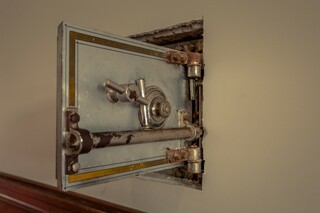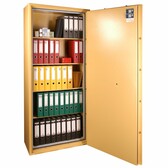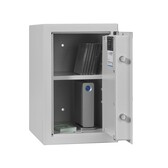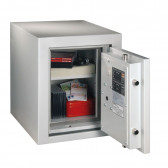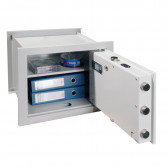Many people keep cash, jewellery, works of art, rare collections or other expensive items at home. Unfortunately, not everyone protects their possessions properly. Buying a safe is a sensible solution that will give you peace of mind. A certified safe for expensive items will effectively protect your belongings from thieves. The correct installation of a safe will increase your security.
How do I install a safe so that a burglar will not rob it?
Before you mount the safe, put yourself in the burglar's shoes. How will he want to steal your property? First of all, he will have to find the safe, so it should be installed out of sight.
Mounting the safe in the wall is a good option, but make sure it is covered by a painting or portrait. A robber will try to defeat the lock's security features after finding the safe. If you have bought a safe with certified security features, you can rest assured – a thief will not open it.
A burglar may try to break down the door. Safes with a certified security class are safe because they have solid bolts and reinforced hinges. The reinforced metal plate of a brand-name safe protects against being drilled and will not yield even to diamond drills.
The last way in which a robbery can be committed is by stealing the safe together with its contents. Mounting the safe in the wall will guarantee that a burglar will not steal it. Some models you can hide in the floor – go to the floor safes category, if such a model interests you. Larger safes, although they are difficult to move without special equipment, are additionally anchored in the floor and wall.
Mounting the safe in a cupboard is also a good option, we recommend furniture safes for this purpose. This way you can hide your valuables well. Being firmly bolted to the floor will ensure that even a small safe cannot be taken out.
Who is most likely to break into a safe?
Buying a certified model and installing the safe in the wall will not always protect you against robbery. Discretion is very important. Make sure nobody is looking when you open the safe. Unauthorised people can see the code.
As police statistics show, burglaries are very often committed by people who have already visited the robbed house before. This could be a cleaner, a plumber, a babysitter or a satellite TV installation crew. Also watch out for nosy friends. The safe should be installed in a room that is not accessible to third parties. A good choice would be a dressing room, bedroom or study.
Find out how to protect your home against theft and burglary
Mounting a safe in the wall – practical tips
Mounting a safe in the wall is not a complicated project. It is best if you plan where to install it during the construction of your home. If you want to install the safe in a place where you already live, then you need to expect a little renovation and adaptation of the wall.
The wall in which you want to place the safe must be thick enough (10 cm thicker than the depth of the safe). If you do not have such a wall, have another layer of bricks added. The hole in the wall should be about 10 cm wider and higher than the safe itself. After making the hole, the surface should be primed.
Before installation, protect the door and lock of the safe from dirt and damage. Cement the safe in place with a metal mesh. Do not use quick-drying mortars. Choose a thin cement to fill the gaps in the opening thoroughly.
Before you buy a safe, think about which model is best for you
There are many different models of safes on the market for different purposes. The most important thing is to choose a certified version with the appropriate security class. Cheap, budget models sold in supermarkets and classifieds do not meet European requirements and standards.
Cheap safes without a certificate can be easily opened and destroyed. Buy a branded model with a high burglary resistance class and you will be sure that your property is safe. Also pay attention to the security class of the lock. Those fitted to home safes should be class A.
If you don't want to place an armoured box in the wall, then choose to install the safe in a cupboard. This solution is quicker and does not require forging a hole in the wall. To do the installation correctly, you need to drill through the cupboard panel and anchor the safe to the floor or wall.
A very important consideration is the dimensions of the safe. Think about whether you will need more space in the future. It may be worth investing in a large free-standing safe to accommodate additional documents. Large armoured cabinets are more secure than small safes because, due to their weight, they cannot be lifted out without the use of specialist equipment. Free-standing safes are also anchored to the wall and floor.
An interesting and aesthetically pleasing solution are armoured display cabinets fitted with multiple layers of toughened glass. In such a safe you can display your collection of weapons, works of art or valuable jewellery.
If you have made the decision to buy a safe, you will certainly be pleased with such an investment. Safes are slowly becoming standard equipment in every modern home. Buy a high-security model and you will be able to leave your home unattended without any worries.
